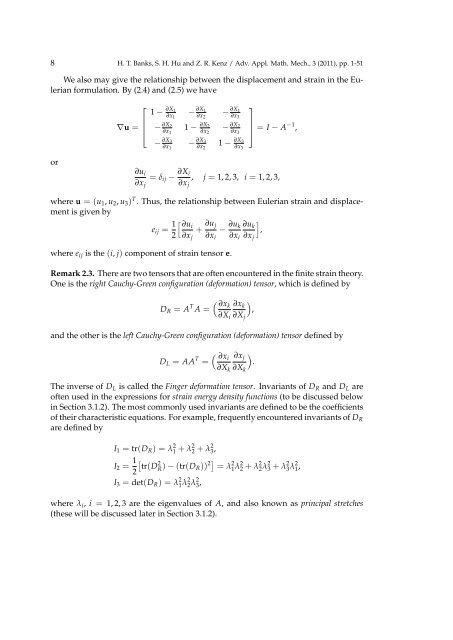A Brief Review of Elasticity and Viscoelasticity for Solids 1 Introduction
A Brief Review of Elasticity and Viscoelasticity for Solids 1 Introduction
A Brief Review of Elasticity and Viscoelasticity for Solids 1 Introduction
You also want an ePaper? Increase the reach of your titles
YUMPU automatically turns print PDFs into web optimized ePapers that Google loves.
8 H. T. Banks, S. H. Hu <strong>and</strong> Z. R. Kenz / Adv. Appl. Math. Mech., 3 (2011), pp. 1-51<br />
We also may give the relationship between the displacement <strong>and</strong> strain in the Eulerian<br />
<strong>for</strong>mulation. By (2.4) <strong>and</strong> (2.5) we have<br />
∇u =<br />
⎡<br />
⎢<br />
⎣<br />
1 − ∂X 1<br />
∂x 1<br />
− ∂X 1<br />
∂x 2<br />
− ∂X 1<br />
∂x 3<br />
− ∂X 2<br />
∂x 1<br />
1 − ∂X 2<br />
∂x 2<br />
− ∂X 2<br />
∂x 3<br />
− ∂X 3<br />
∂x 1<br />
− ∂X 3<br />
∂x 2<br />
1 − ∂X 3<br />
∂x 3<br />
⎤<br />
⎥<br />
⎦ = I − A−1 ,<br />
or<br />
∂u i<br />
∂x j<br />
= δ ij − ∂X i<br />
∂x j<br />
, j = 1, 2, 3, i = 1, 2, 3,<br />
where u = (u 1 , u 2 , u 3 ) T . Thus, the relationship between Eulerian strain <strong>and</strong> displacement<br />
is given by<br />
e ij = 1 [ ∂ui<br />
+ ∂u j<br />
− ∂u k ∂u<br />
]<br />
k<br />
,<br />
2 ∂x j ∂x i ∂x i ∂x j<br />
where e ij is the (i, j) component <strong>of</strong> strain tensor e.<br />
Remark 2.3. There are two tensors that are <strong>of</strong>ten encountered in the finite strain theory.<br />
One is the right Cauchy-Green configuration (de<strong>for</strong>mation) tensor, which is defined by<br />
D R = A T A =<br />
( ∂xk ∂x<br />
)<br />
k<br />
,<br />
∂X i ∂X j<br />
<strong>and</strong> the other is the left Cauchy-Green configuration (de<strong>for</strong>mation) tensor defined by<br />
D L = AA T =<br />
( ∂xi<br />
∂X k<br />
∂x j<br />
∂X k<br />
)<br />
.<br />
The inverse <strong>of</strong> D L is called the Finger de<strong>for</strong>mation tensor. Invariants <strong>of</strong> D R <strong>and</strong> D L are<br />
<strong>of</strong>ten used in the expressions <strong>for</strong> strain energy density functions (to be discussed below<br />
in Section 3.1.2). The most commonly used invariants are defined to be the coefficients<br />
<strong>of</strong> their characteristic equations. For example, frequently encountered invariants <strong>of</strong> D R<br />
are defined by<br />
I 1 = tr(D R ) = λ 2 1 + λ2 2 + λ 2 3 ,<br />
I 2 = 1 2[<br />
tr(D<br />
2<br />
R ) − (tr(D R )) 2] = λ 2 1 λ2 2 + λ 2 2 λ2 3 + λ 2 3 λ2 1 ,<br />
I 3 = det(D R ) = λ 2 1 λ2 2 λ2 3 ,<br />
where λ i , i = 1, 2, 3 are the eigenvalues <strong>of</strong> A, <strong>and</strong> also known as principal stretches<br />
(these will be discussed later in Section 3.1.2).

















